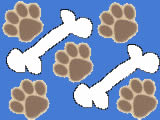Dog - Human Communication
"Don't accept your dog's admiration as conclusive evidence
that you are wonderful." -- Ann Landers
What is your dog trying to say to you? What does that bark mean? Are his hackles up? What about the ears and tail? Is your dog anxious or does she just want to play? Dogs learn to communicate with each other from their mothers and siblings in the puppy pack. They do this through play and a hierarchy is established. They use specific signals to communicate certain things to each other. Dogs look at our body language for direction. We’d like to think they understand human language, but they look at our body language and listen to the ton of our voice more than having an actual understanding of our words. Your dog communicates with you all the time, whether you realize it or not. Canine language takes the form of facial expressions, ears, tail, body movement and sound. If you know what your dog is saying, you can anticipate problems before they start. This is particularly important in a situation such as group obedience class or if your dog is off leash at the park.
Pay attention to:
- What your dog looks like when it’s relaxed.
- What your dog looks like when it is defending its territory or a toy.
- What your dog looks like when it is scared or unsure about something.
- What your dog does when it meets another dog.
- What your dog is doing when it is playing versus when it is getting ready to bite.
- Your dog’s vocalization. What does that growl or bark mean? Is it playful or more serious?
Our dog’s facial expressions are similar to ours, which helps us to understand when they are happy or sad, bored or alert-although we can misinterpret their actions. They will also bark or growl a certain way to express emotions as well. Our tone of voice changes depending on what we are feeling. Dogs are the same, only they use barks and growls to express it.
If your dog is aggressive, watch for the signs of aggression and as soon as you see it beginning, shut it down. Redirect your dog’s attention away from the other dog, with your voice, treat or toy. Reward your dog for paying attention to you and not the other dog. If your dog is on leash and meeting another dog, be careful not to hold the leash too tightly. This will force your dog to stand very tall, head up, chest out, which could be misinterpreted by the other dog as an aggressive stance. Keep the leash loose and remain relaxed.
Next time you’re in class, or in another social situation with your dog, watch how you r dog interacts with other dogs. Does your dog usually take on a submissive or dominant stance? Is your dog the first one to start an argument or does it run for cover? Knowing your dog’s personality will help with your training. You would not train a dominant dog the same way you would a submissive dog as they have different needs. See page 3 for a Personality Quiz. Take the quiz to see what personality traits are the strongest in your dog. It will help you understand what’s going on in your dog’s head and enable you to tailor your training to your dog’s specific needs. Also, on page 5 and page 6, there are body language charts that show some of the common behaviors your dog uses to communicate. Note: If your dog has a docked tail, the stub will still react in the same way as a dog with a tail since the muscle control is the same. You will simply have to pay more attention to facial and body language cues in order to know what your dog is telling you.
Remember, if you have your dog on leash, he or she will feel whatever you feel. That leash is like an umbilical cord. If you’re anxious, the dog will sense it and become anxious. If your dog is meeting another dog for the first time, your dog may feel your anxiety and show fear aggression towards the other dog because he or she senses it in you. If we are anxious or worried, the smell of our breath, as well as our body scent, changes. Our body language and tone of voice can change in the most subtle of ways, although we may not be aware of it. Don’t think you can fool your dog. They are experts in reading body language.






